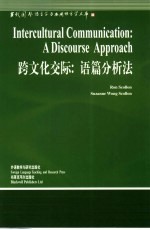图书介绍
跨文化交际 语篇分析法PDF|Epub|txt|kindle电子书版本网盘下载

- (美)RonScollon,(美)SuzanneWongScollon著贾玉新导读 著
- 出版社: 北京:外语教学与研究出版社
- ISBN:756001934X
- 出版时间:2000
- 标注页数:276页
- 文件大小:14MB
- 文件页数:306页
- 主题词:文化语言学(学科: 研究) 文化语言学
PDF下载
下载说明
跨文化交际 语篇分析法PDF格式电子书版下载
下载的文件为RAR压缩包。需要使用解压软件进行解压得到PDF格式图书。建议使用BT下载工具Free Download Manager进行下载,简称FDM(免费,没有广告,支持多平台)。本站资源全部打包为BT种子。所以需要使用专业的BT下载软件进行下载。如BitComet qBittorrent uTorrent等BT下载工具。迅雷目前由于本站不是热门资源。不推荐使用!后期资源热门了。安装了迅雷也可以迅雷进行下载!
(文件页数 要大于 标注页数,上中下等多册电子书除外)
注意:本站所有压缩包均有解压码: 点击下载压缩包解压工具
图书目录
1 What is a Discourse Approach?1
The Topic2
Professional communication3
Interdiscourse communication4
Discourse5
The Limits of Language5
Languages is ambiguous by nature6
Preface by Halliday9
王宗炎序10
We must draw inferences about meaning10
Our inferences tend to be fixed,not tentative10
What is Successful Interdiscourse Professional Communication?11
Our inferences are drawn very quickly11
Expecting things to go wrong12
Dealing with miscommunication13
Increasing shared knowledge13
Two Approaches to Interdiscourse Professional Communication13
导读13
2How,When,and Where to Do Things with Language16
Sentence Meaning and Speaker s Meaning18
Speech Acts,Speech Events,and Speech Situations19
Grammar of Context21
Seven Main Components for a Grammar of Context22
Scene24
Key26
List of Figures27
Participants27
Series Editor s Preface28
Message form28
Sequence29
Preface29
Co-occurrence patterns,marked and unmarked30
Manifestation31
3 Interpersonal Politeness and Power33
Communicative Style of Register33
Face34
The Paradox of Face:Involvement and Independence36
The“Self”as a Communicative Identity36
Politeness Strategies of Involvement and Independence38
Linguistic Strategies of involvement:some examples40
Linguistic Strategies of independence:some examples41
Politeness(or Face)Systems41
Power(+P,-P)42
Distance(+D,-D)43
Weight of imposition(+W,-W)43
Three Politeness Systems:Deference,Solidarity,and Hierarchy44
Deference politeness system(-P,+D)44
Solidarity politeness system(-P,-D)45
Hierarchical politeness system(+P,+/-D)45
Miscommunication47
4Conversational Inference:Interpretation in Spoken Discourse50
How Do We Understand Discourse?51
Cohesive Devices:Lexical and Grammatical53
Reference53
Conjunction54
Verb forms54
The causal conjunction“because”55
Cognitive Schemata or Scripts56
World knowledge58
Adjacency sequences59
Prosodic Patterning:Intionation and Timing60
Intonation60
Timing63
Metacommunication66
Non-sequential processing69
Interactive Intelligence72
5 Topic and Face:Inductive and Deductive Patterns in Discourse74
What Are You Talking About?74
Topic,Turn Exchange,and Timing75
The call-answer-topic adiacency sequence76
The call76
The answer77
The introduction of the caller s topic77
Deductive Monologues78
The Inductive Pattern79
Inside and outside encounters80
Hierarchical Confucian relationships and topic introduction81
The false east-west dichotomy82
Face:Inductive and Deductive Rhetorical Strategies83
Topics and Face Systems85
Face Relationships in Written Discourse87
Essays and press releases89
The press release:implied writers and implied readers90
The essay:a deductive structure91
Limiting Ambiguity:Power in Discourse92
6 Ideologies of Discourse94
Three Concepts of Discourse94
The Utilitarian Discourse System98
Ideology of the Utilitarian discourse system99
The Enlightenment:reason and freedom100
Kant s view of the“Public”Writer101
Bentham and Mill s Utilitarianism101
Socialization in the Utilitarian discourse system104
Froms of discourse in the Utilitarian discourse system106
The Panopticon of Bentham112
Face systems in the Utilitarian discourse system113
Internal face systems:liberté,égalité, fraternité114
Multiple Discourse Systems117
7 What is Culture? Intercultural Communication and Stereotyping122
How Do We Define“Culture”?125
Culture and Discourse Systems127
Ideology128
Face systems129
Forms of discourse137
Socialization148
Cultural Ideology and Stereotyping154
Negative Stereotypes158
Positive Stereotypes,the Lumping Fallacy,and the Solidarity Fallacy159
Differences Whice Make a Difference:Discourse Systems161
8 Corporate Discourse164
Discourse Systems164
Voluntary and involuntary discourse systems166
Five Characteristic Discourse Systems168
An Outline Guide to the Study of Discourse Systems170
The Corporate Discourse System(Corporate Culture)172
Ideology173
Socialization178
Forms of discourse183
Face systems191
The size and scope of corporate discourse systems192
The Professional Discourse System(ESL Teachers)194
9 Professional Discourse194
Ideology195
Socialization198
Forms of discourse200
Face systems202
Other professional discourse systems203
10 Generational Discourse205
Involuntary Discourse Systems205
The ideologies of American individualism207
Four generations of Americans209
The shifting ground of American individualism221
Asian Generational Discourse Systems223
Communication Between Generations225
11 Gender Discourse229
Intergender Discourse229
Directness or indirectness?229
Different interpretive frames232
The origin of difference:ideology and paradox237
The maintenance of difference:socialization240
Messages and metamessages:forms of discourse242
The struggle for equality,the struggle for power243
Further Research on Gender Discourse Systems244
Discourse Systems and the Individual245
Intersystem Communication248
References253
The Research Base253
References for Further Study257
Index267
文库索引272